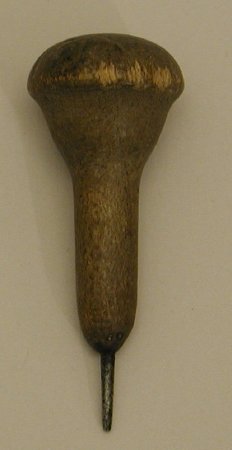Object ID:
2006.52.1-2
Title:
New York point slate and stylus
Description:
A swivel pocket slate with 3 lines of 36 cells for writing New York point. Back plate has furrows (grooves). A removable pin fits into the end of the slate opposite the swivel pin and keeps the slate closed when not in use. A hand-inscribed company name appears on the back plate, but is not completely legible: the first part of the name is "James" and the second part begins with "B" followed by "and Co." Stylus has a wooden handle and metal tip.
.1 - slate
.2 - stylus
.1 - slate
.2 - stylus
Dimensions:
H-1 W-8.25 inches
Date:
ca. 1905
Made by:
[unknown]
Place of Origin:
[unknown]
Provenance:
The donor, a former student at the Michigan School for the Blind, purchased them through eBay.
William Bell Wait, Superintendent of the New York Institution for the Blind, introduced New York Point in 1868 and it quickly replaced line letter in most U.S. schools. NY Point characters were two dots high and of variable width, and could be written using a slate similar in design to those used for braille. Point began to decline rapidly in popularity following the decision in 1909 by New York to adopt braille. New York Point slates remained in the APH catalog, however, until 1932.
William Bell Wait, Superintendent of the New York Institution for the Blind, introduced New York Point in 1868 and it quickly replaced line letter in most U.S. schools. NY Point characters were two dots high and of variable width, and could be written using a slate similar in design to those used for braille. Point began to decline rapidly in popularity following the decision in 1909 by New York to adopt braille. New York Point slates remained in the APH catalog, however, until 1932.
Credit Line:
Gift of Rodney Shaw, 2006.52

